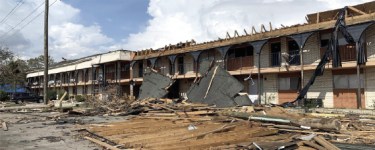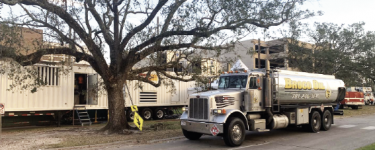All
More Essential than Ever

Heating fuel dealers confront dual challenges: COVID-19 and busy heating season
In May 2020, Oil & Energy published a feature article on heating fuel industry stakeholders stepping up to assist in first responders’ coronavirus relief efforts. It was a big story: five pages detailing the firsthand accounts of Bioheat® fuel and propane marketers delivering fuel to testing sites, providing standby power for hospitals, and even donating meals to firefighters and nursing homes.
Perhaps lost somewhere in this story of exceptional heroism was the simple fact that heating fuel dealers and wholesalers also faced the same challenge that has confronted millions of companies around the world — the challenge of doing business during a pandemic. Additionally, the need for heating fuels and equipment services wasn’t going away; if anything, it could have been increasing as customers spent more time at home.
Thus, as a second surge of COVID-19 cases swept across the Northeast in the fall of 2020 and early winter of 2021, Oil & Energy followed up with three of the heating fuel marketers featured last May to find out more about how the pandemic was affecting their daily operations. The stories we heard, which we are eager to share here, were nothing short of remarkable. However, as in May, it should again be noted that these are the accounts of just a few heating fuel providers. Since no two businesses are exactly alike, no two stories are exactly the same, but all of them deserve to be told and heard, especially in times like this.
Demand Changes
There has been a lot of talk in the trade lately about an increase in demand for residential heating fuels. Many customers are working from home. Some also have children who are attending school remotely. Others find themselves out of work or in early retirement. All of this, the story goes, should add up to a substantial boost in residential heating fuel consumption.
But has that played out as expected?
For Haverhill, Massachusetts-based Broco Oil, the answer was decidedly yes. Moreover, the trend actually started at the end of last heating season. “March to May 2020 was the busiest spring we’ve ever had,” said Bob Brown, who co-owns the family business with his wife, Angela. “We noticed an increase where people who normally take 1,000 gallons a year used 20 percent more fuel for their heat and hot water.”
Broco Oil didn’t anticipate the pandemic lasting this long, but was nonetheless prepared, no doubt thanks in part to the company’s experience providing disaster relief. “Being an emergency fuel provider, we maintained operational readiness year-round and are able to respond and adapt to any situation that requires an abrupt demand increase such as what we saw in residential heating oil,” said Brown.
Queens, New York-based Skaggs-Walsh also saw some customers using more fuel than usual, but their increased consumption was balanced out by other pandemic-related factors. “For every one of those houses, we have another that is vacant because the owner didn’t come home from Florida or stayed in their country home instead of coming back to the city,” said the company’s owner and president, Allison Heaney.
Still, Skaggs-Walsh had prepared for an up-tick in demand and remained ready should a crippling cold front descend on the New York metro area. “We always keep a fairly large reserve in customers’ tanks, as we find just-in-time deliveries aren’t right for our customer base,” Heaney explained. “The homes that we serve tend to be quite old — many of them 80-100 years old — and their tanks tend to be quite old as well,” putting them at greater risk of sludge accumulation the longer they go unfilled, she reasoned.
“Additionally we’re a very working-class company,” Heaney continued. “Our customers are people who work for a living, and many live paycheck to paycheck, so if they haven’t chosen to be a budget plan customer, they’re paying delivery to delivery. It suits our business model. When a brutal cold snap comes, as in early 2018, a lot of our competitors had runouts and we didn’t have that problem because although that Polar Vortex really did alter usage beyond the degree day calculations, we were ready for it.”

Throughout the pandemic, as always, demographics and location have continued to play defining roles in determining customers’ heating fuel demands. For example, in more remote areas with fewer homes and fewer companies, urban flight might have helped raise demand. This was the case for D.F. Richard of Dover, New Hampshire.
“We have seen homeowners within our service area, who have other residences within the cities, moving to the homes we service on a permanent basis,” said D.F. Richard Chief Operating Officer Ryan Jackson.
According to company data, an overall increase in demand could certainly be attributed to more customers spending more time at home. “We have K-factors being cut in half in some instances,” Jackson explained. “We noticed this as soon as the cooler weather came in December, but had already expected it a little from analytics we were looking at from the fall months. It seems that thermostats are not being set back, because families are home and not at work.”
To brace for such dramatic K-factor swings, D.F. Richard had to take some drastic measures. “We pulled deliveries much further ahead — sometimes as much as 300 degree days ahead — to make sure we would catch the higher users,” Jackson said. “We have also deployed many tank monitoring devices from Anova and Otodata to make sure we know exactly what the customer has within their tank.”
Jackson noted that increased use of propane appliances, such as fireplaces and other visual flame products, has helped further drive sales at D.F. Richard. This could have also contributed to the continued increase in demand at Broco Oil, as the company added propane delivery and service to its offerings during 2020.
Supply Chain Disruptions
Facemasks and hand sanitizer weren’t the only goods in short supply after the pandemic hit. “During the summer, air conditioning parts were very scarce for all of the jobs we did,” said Skaggs-Walsh President Allison Heaney. “Anything that comes out of Europe is virtually shut down, so boiler and oil tank manufacturers have also experienced production chain delays. Some equipment shortages have gotten better and others have gotten worse. The A/C parts are easy to get now, but we are already stocking up for next season because the only way to get done what you need is to control the inventory. We’ve instituted a program where we’re keeping more inventory than normal. Normally we’d keep five to six boilers on hand, now we have 18. Normally we’d keep two to three tanks on hand, now we’re trying to keep five to eight. We’ve essentially tripled everything.”
Employee Challenges
At the time of this writing in mid-January, the U.S. had recorded nearly 23 million COVID-19 cases since the beginning of the pandemic and over 1.7 million new cases in the last seven days alone. Not surprisingly, employee exposure remained a serious concern for heating fuel dealers, especially those in densely populated areas.
“Every day there’s a new person who may have been exposed or whose child could be sick,” said Heaney. In addition to creating staffing challenges, this presented a number of other difficulties, especially at the start of the pandemic. Heaney tallied off a few of the questions that were on many business owners’ minds: “What constitutes exposure? How long do you need to quarantine? When do you need to get tested? What result do I need?”
Even up in New Hampshire, where there were far fewer reported cases, companies were challenged by employee absences. “While we have not had a positive case within the company — knock on wood — we have had close contact cases where employees had to quarantine and get tests,” said Jackson. “During the busy fall season, when we had a technician in quarantine, others had to pick up the slack and it takes a toll on them. The same with our delivery drivers — while not positive for COVID, we have had a few that needed to quarantine because of a close contact and wait for test results.”
Social distancing, mask protocol, and work-from-home assignments have also posed challenges for maintaining workforce morale. “Immediately on March 12, we stopped allowing people into the office except those who need to be here,” Heaney recalled. “Service techs and drivers don’t come inside the office — instead we exchange parts and tickets through a basket — so there’s the isolation of not seeing them face-to-face and not being able to have that water cooler talk with them.” Heaney added that she has been calling each employee on staff every month or two “just to check in and see how they’re doing.”
To date, Skaggs-Walsh has kept five employees working remotely full-time. “It’s taken quite a bit of time to get it all set up and get protocol in place,” Heaney said, “but God forbid there’s another disaster, we’re now much better poised to handle that inability to come to the physical workplace here in College Point. That feels good. We’ve always known that was an Achilles’ heel and now it’s not.”
According to Jackson, technology has been a huge help for D.F. Richard. In addition to the aforementioned tank monitors, the company has integrated other remote devices and platforms into its quarantine plans and daily operations.
“We had already automated some of our delivery fleet and all our service fleet within the last couple of years, so this has helped tremendously,” Jackson said. The company has used ADD Systems E3Æ software’s RavenÆ and PegasusÆ components to keep drivers and technicians connected with the back-office in real time.
Still, some at D.F Richard were concerned about the lack of a central communication point. To fill this gap, the company adopted an app called WorkJam. “This has allowed us to connect with all our employees on one platform, issue self-health screening surveys, and really have one location for everyone to communicate,” Jackson said, adding, “All the changes that we have made will remain permanent for the future, as it really has opened our eyes to many things we would have not seen in a normal non-pandemic time.”
Efficiency Improvements
For Heaney and Skaggs-Walsh, the pandemic has provided opportunities to identify and eliminate a number of inefficiencies. Many of these changes came about by necessity rather than choice, but the “unintended consequences” have been profound.
“When New York City shut down, we stopped doing routine maintenance and tune-ups,” recalled Heaney. “That was rough because once we shut it down, we didn’t start it back up until mid-June, and we found ourselves three and a half months behind. However, we learned from this that we really don’t need to book too far out in advance. In the past, we were trying to be so specific in terms of meeting customers’ scheduling needs that we may have boxed ourselves into corners. We’ve found customers are much more flexible when they’re home, so we can be more flexible too. We’ve backed off the more exacting time frames, and it’s been much better for us.”
Additionally, Skaggs-Walsh was able to boost customer service efficiencies simply by eliminating “busy” work. “During non-COVID times, employees were perfectly happy to call customers before deliveries because they have a gate or have a dog, or they wanted to tell someone not to park in the driveway,” Heaney said, “but with reduced staff, you can’t make all of those calls. Customers are really reacting pretty well to it, and that makes us a more efficient company, which is a great outcome we’ll try to maintain moving forward.”
Closing the Skaggs-Walsh offices to all but a select few employees showed Heaney how much time and manpower could be saved by connecting with her fellow industry stakeholders remotely rather than in person.
“Before the pandemic, truck equipment vendors would come in to get the ear of mechanics, boiler manufacturers would come in to push their products, and even folks who work in wholesale terminals would want to do site visits,” Heaney said. “It’s just a huge time-saving not having them here,” she admitted. “Even insurance brokers: a renewal that could’ve taken 12 to 14 hours of human time, which is really unnecessary, can now be taken care of in a two-hour phone call!”
An active member of several industry associations, Heaney also realized “unbelievable time-savings” by attending meetings remotely. “With ZOOM meetings, you literally spend only the time of the meeting, whereas when they were offsite there was all the travel time there and back,” she said. To those familiar with New York traffic, this needed no further explanation.
“...we were fully staffed for the winter months ahead.”
The coronavirus wasn’t the only crisis Broco Oil confronted in 2020. Owner Bob Brown explains: “Broco Oil was activated to handle the emergency fuel for the city of Lake Charles, Louisiana in the aftermath of Hurricane Laura. With an overly active hurricane season, we ended up being assigned to Lake Charles for over two months, which set our fleet back. Since we are able to act and overcome any situation, we quickly purchased half a dozen fuel trucks and back filled them with new hires. It actually ended up being a blessing because when the guys returned from Lake Charles in the first and second weeks of November, we were fully staffed for the winter months ahead.”


Personal Takeaways
Speaking to the extreme nature of the current circumstances, the business leader Oil & Energy spoke with who seemed least personally affected was the one who’s also a U.S. Navy Seabee veteran and a captain in the Chelsea Fire Department. “Being third generation of a family of veterans and firemen, I’ve been raised to expect the unexpected and be prepared for the worst,” said Broco Oil’s Bob Brown.
Other heating fuel dealers have, understandably, had a tougher time adapting. Asked how she was personally handing the crisis, Heaney responded, “Not great,” with a laugh. As with her business, though, she was managing to make the best of the situation: using ZOOM to take Pilates classes and stay in touch with friends and colleagues, for example. “We even figured out how to do Poker on Friday nights, something we were missing,” she said.
For Jackson, the pandemic has helped put things in greater perspective. “While at times it has been stressful, this pandemic really brings out the true meaning of family, whether it is at work or at home,” he said. “Not going out to eat, not shopping in a retail location, and not visiting other friends and family has been tough, but it has forced us to adapt. We now do things as a family that we might not have done together as much in the past: game nights, movie nights, etc.
“I have tried to expose myself to the same individuals only and minimize exposure to others as much as possible,” Jackson continued. “While it is tough, it always must remain in the back of my head.”
Ending on a positive note, Heaney gave voice to another sentiment that has likely been in the back of the minds of many dedicated business owners and essential workers. “I have to tell you,” she said, “I am longing for that shot, to get out of Dodge and just go away anywhere, it doesn’t really matter where. Not having that has been a struggle, but I 100-percent believe the end is super close. We can see the light at the end of the tunnel.”
We can too, and we thank industry leaders like Allison Heaney, Ryan Jackson and Bob Brown for helping us get there.
Related Posts
 Why Quality Matters in Your Biofuel Blends
Why Quality Matters in Your Biofuel Blends
Posted on June 25, 2025
 Incorporating Higher Blends of Biofuels
Incorporating Higher Blends of Biofuels
Posted on May 14, 2025
 NORA Programs at Eastern Energy Expo
NORA Programs at Eastern Energy Expo
Posted on May 13, 2025
 March Short-Term Energy Outlook
March Short-Term Energy Outlook
Posted on April 28, 2025
Enter your email to receive important news and article updates.
